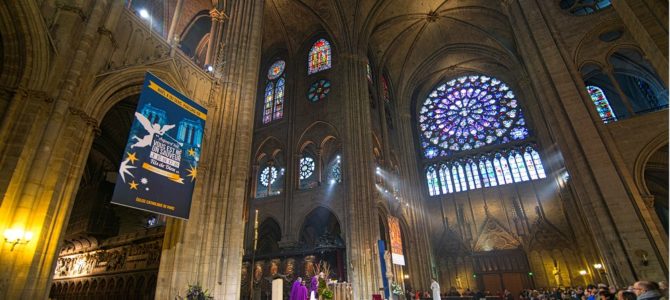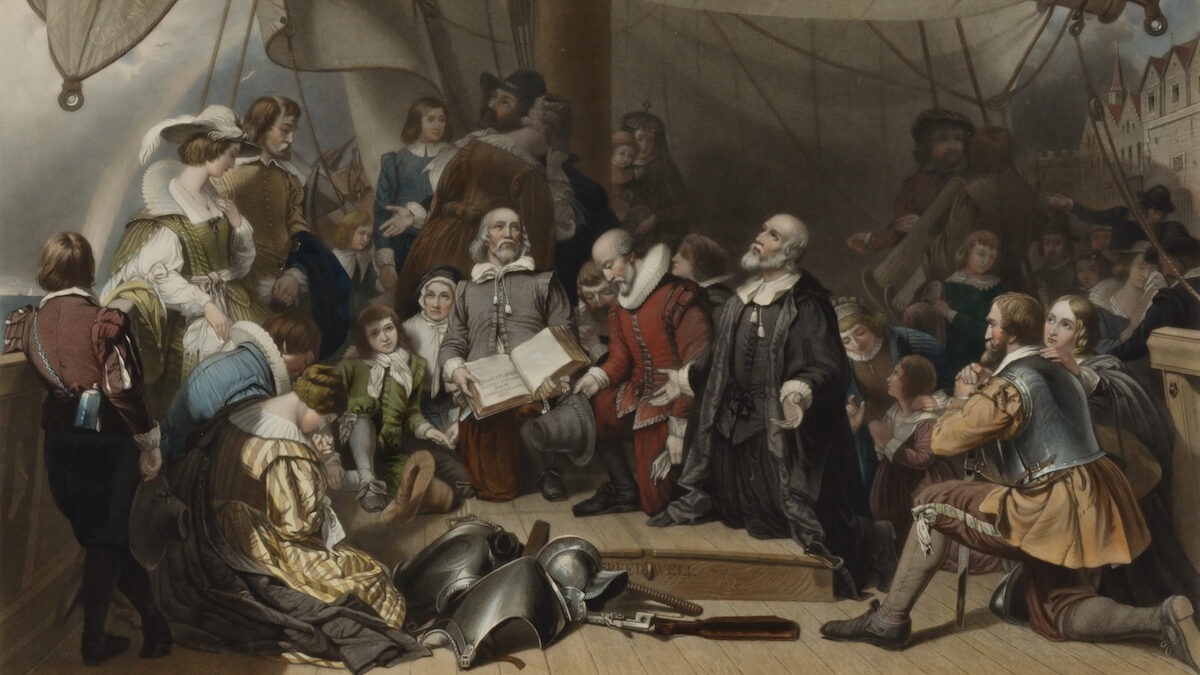
If one were going to choose the most important church in the world, the Cathedral of Notre Dame de Paris (with the possible exception of the St. Peter’s Basilica in Rome) would top the list. Built over the better part of two centuries, an era spanning nearly the entire Gothic period, the cathedral’s construction was funded by Christian benefactors from all around late-medieval France.
The fruit of their donations, a building named for Our Lady—who carried the God-man in her very self—continued for eight centuries. Countless people who entered the cathedral’s doors were led to a profound experience of the divine. Known as “the poor people’s book,” the building told salvation history through images and paintings for those millions who either could not read or did not have access to texts.
But we should not shrink from the hard truth about what Notre Dame de Paris became. Many millions more now have visited the building annually as a historical monument than who entered to commune with the transcendent. Notre Dame is, in many ways, much closer in the West’s cultural imagination to a Temple of Apollo than a home of the living God. It’s become a historical and beautiful curiosity that signals a time, now past, in which the people who went before us believed some, well, nutty stuff.
Indeed, the smoldering ruin of the cathedral now stands as a tragic metaphor for the church, not just in France, but in much of the developed West more generally. The structure or shell is still largely intact, but the building itself has been gutted.
Yes, there are still priests. There are still churches. There are still schools and hospitals. But the heart of the church—worn away over time by riches and consumerism, moral relativism and hyper-secularism—is no longer there.
While the burnt-out church is a metaphor for the role of Christianity in the developed West, the major media coverage of its burning was a performance. Although ostensibly a church—with significance primarily as a house of worship—the main media stories rely on the historical, artistic, and social significance of the cathedral for their gravity.
At the time I write this, for instance, the New York Times headlines on the story had exactly zero religious references. They did mention, of course, the building as “an iconic symbol of the beauty and history of Paris” and “a jewel of Medieval Gothic architecture.”
Yet, despite all of this darkness, what will likely come to be known as simply “the fire” may in fact be a sign of hope, particularly during this Holy Week in advance of Easter. In churches all over the world that will celebrate the Easter vigil on late Saturday night into early Sunday morning this week, for instance, roaring fires will be lit as a sign of God’s grace and power in the midst of a powerful darkness.
It’s a darkness that cannot shut out the light. From those fires many candles will be lit, including the Paschal candle, lit in many churches during special occasions like baptisms and funerals.
The fact that the Notre Dame Cathedral fire took places at the beginning of Holy Week is no accident. Christians know better. An Anglican bishop put it this way yesterday:
https://twitter.com/gavinashenden/status/1117908540130074624
French President Emmanuel Macron has said that Notre Dame de Paris will be rebuilt. But what is it, precisely, that will be rebuilt? Will it essentially be a museum, a mere symbol or repository of the history and beauty of Paris and France? Or will it be something more? Will what comes from the ruins be an actual house of prayer?
Much depends on the response of Christians. St. John the Baptist realized repentance was necessary for those seeking a genuine experience of God. Whether Monday’s fire is one of judgement or one of healing, hope, and restoration will indeed depend on capacity for repentance.
The call for this may need to come from outside the developed West, infected as we are with the kind of social arrogance that makes calls for such repentance something close to absurd. The church is thriving in places like Africa and Asia, and it may take their evangelical zeal to help us see our hubris and need for repentance. Indeed, much of the money collected worldwide for the rebuilding of Notre Dame de Paris will likely come from energetic, faith-filled, exponentially growing numbers of Christians on these two continents.
For what will they be paying? Much like the funders of the original cathedral, they will put their resources into a building they hope will bring people closer to Christ. This holy week, there is more than the usual hope that such goals could actually be realized. In just a few days, Christians will commemorate the fact Jesus’ lifeless body remained in the tomb three days.
On Easter Sunday we will celebrate and even experience the power of God in the raising that body from the dead. For 2,000 years, Jesus’ body has been a metaphor for the church. Christians pray in a special way each Easter that the Body of Christ, the church, may be renewed and vivified through the power of God’s grace. The roaring fire built in the darkness of the Easter vigil is a powerful symbol of that hope even when things appear to be at their worst.
Despite the horrific fire, the altar and pulpit of Notre Dame de Paris survive. Its walls are unmoved. A cross still hangs majestically over the smoking debris. Could Notre Dame de Paris once again be a living, vibrant home for Christ’s body, the church?
Here is an unmistakable invitation to conclude this Lent with a spirit of repentance that will transform what appears to be a terrible defeat and unspeakable tragedy into the means by which a new, living spirit is imbued into what was little more than a lifeless relic of the past. Christians must make the most of the opportunity God has given us to turn what looks like a horrific defeat into a glorious victory.
Hæc ígitur nox est, quæ peccatórum ténebras colúmnæ illuminatióne purgávit.—“Exsultet”









